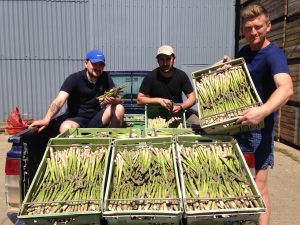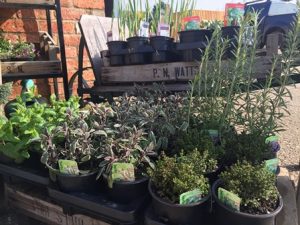
August was wetter and warmer than normal, no records broken here, but I suspect that rainfall records could well have been broken in the west of Scotland. Nearly all of our rain fell in the first half of August, 70mm of it and we ended up with 76mm or 3 ins in total and the average temperature was 18.02°C. The warmest August we have had in the last 50 years was in 1997 when the average was 19.84°C.

We normally think of wheat being fairly weatherproof but the heavy rain showers in August had shed about a quarter of it on to the ground. Depending on the variety, we estimate that the quantity of rain cost us about £100,000. We have a weighbridge, weighing everything in to the stores which advises us how each variety has fared and also how well wheat yields after each break crop, such as peas. Every load of produce that goes off the farm is also weighed, except sugar beet.
If we were to totally follow the profit figures then we wouldn’t have a proper rotation, we would just grow wheat and rape. That is what many farmers do and it has worked for a number of years. This farming method however has encouraged the growth of blackgrass, which is such a devastating plant. It germinates in Autumn and by sowing every crop in the autumn it has suited blackgrass so now farmers are forced to grow spring beans and spring barley to combat blackgrass.
We finished the wheat harvest on September 3rd and have been busy drilling oil radish. It is drilled direct into the wheat stubble without cultivating, and is a catch crop which conditions the soil. It also captures the nitrogen in the soil so if we get heavy rain, it doesn’t leach out of the soil. Also, the land will not blow, water is less likely to run off the field if there is a green crop on it and it attracts wildlife, especially Lapwings.
The hot weather over the August bank holiday suited the millet and sunflower crops and we will continue to watch them so that they can be sprayed off at the right time and harvested when ready. The red millet was first, followed by the white millet a week later and sunflowers will be in the last few days of September. Every day gets shorter and more damp and, as only dry material will go through the combine, combining days get considerably less as we go through October.
August has been a time to monitor the potato crops. Every week we went out to each field and dug a six feet long sample, brought it back to the yard, measured and weighed it. We do this to see how big the potatoes are getting – supermarkets do not want potatoes that will not pass through an 85mm square hole. Therefore by sampling them weekly, we know if there is a need to stop them growing. It varies from field to field and variety, they all have to be monitored Those crops that are destined for chips will continue to grow on as the chip factories like big potatoes.
We have a new British-built Standen potato harvester built in Ely – the heart of potato growing country. It is a three row harvester, quite a monster when travelling on the road, but it should speed our potato harvest up. We had been having a lot of trouble with our previous harvester, a Grimme from Germany. Allegedly the ‘Rolls Royce’ of potato harvesters, but it was very complicated, with lots of things to go wrong and very expensive when it did break down as there are a lot of machinery and people involved in the harvesting operation. The new one is far simpler, so we are looking forward to getting it into use.


There have been more insects about this August than usual, some people have commented that they have had more insects on their windscreens than other years. I have a more reliable source than casual observations and that is our colony of Tree Sparrows – they are continuing to nest longer than usual. They feed their young on insects while they are in the nest as every bird has to feed their young on moist food, as they cannot take them any water, the moisture has to be included in the food. There are two exceptions to the eight colonies we have – as they are next to a field of millet they are able to take some unripe seeds to their young which contain moisture. Those two colonies have ignored our feeders this last three weeks and have fed entirely in the millet crop.
As I write this, we have a profusion of butterflies in the garden. Tortoiseshells, stunning Red Admirals, fading Painted Ladies, a Comma, two Peacocks and a Brimstone. Common Blues, Brown Argus, a Small Copper and an Elephant Hawk Moth caterpillar were present last week.
Most of the Warblers have left us now, they have been fattening up on elderberriess, blackberries and insects. By the time you read this, all of our Swallows and House Martins in Lincolnshire will also have left. Wheatears will keep coming through all this month and we expect to see a Stonechat or two soon, as there are a few that winter in this area.
By the time we see Fieldfares and Redwings in October, the summer and shirt-sleeved weather really will have gone.
Barn Owls are doing well, we have three pairs that are having a second brood. There may be more than that as for the second brood, the adults move out of the nest box containing the first brood and nest elsewhere. This means we don’t always know where that second nest site is. Some humans do raise a second family, but not many of us would move out of our house to let our children grow up in it.
Barn Owls usually lay quite a lot of eggs on a second brood but only usually rear one or two young and this seems to be what is happening this year. We have a live camera where the Barn Owl has been sitting on eight eggs and as I write this she has hatched four chicks, so she is doing well. This camera feed can be seen on our website.
As there are a lot of voles around, second broods may do well. A good vole year will be followed by a poor vole year – the young owls will not go far from home when there is plenty of food and because there will be a lot of mouths eating voles they will keep eating them until they become scarce. The young will move away once the voles become hard to find, leaving the adults with meagre supplies. Weather conditions early in the year also play a part – a wet April stops the voles breeding so it becomes a bad vole year. I don’t think there is a vole cycle as such, the number of voles is dependant on the weather and how many birds and animals there are to eat them.
TALKS & EVENTS
19th October – Farming & Wildlife Talk at
Lincolnshire Wildlife Trusts AGM,
Whisby Nature Park, Moor Lane,
Thorpe-on-the-Hill, LN6 9BW



